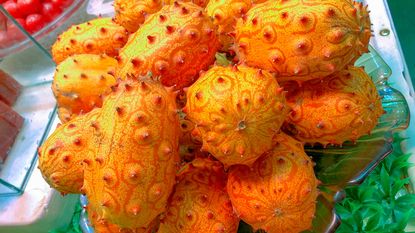Learn About Kiwano Jelly Melon History


Kiwano jelly melon is also known as horn melon, which is apparent when you take a look at this weird, oddly attractive, pear-sized fruit that sports greenish-yellow skin and spiny horn-like protuberances. Growing jelly melons is easy; if you can grow melons in your garden, you can definitely grow kiwano jelly melons.
Facts about Jelly Melon
Jelly melon belongs to the cucurbit family, which means it is cousin to cucumber, squash, and most types of melons. Although the outer skin is firm, the flesh is jelly-like with an abundance of edible seeds. Some people say the flavor is tropical with hints of cucumber, banana, melon and lime, while others describe it as citrus and pomegranate- like. Many people appreciate jelly melon not for its flavor, but for its unusual, long-lasting ornamental value.
Kiwano Jelly Melon History
Unfortunately, kiwano jelly melon history is sketchy, at best. We do know that jelly melon, often known as African horned cucumber, is native to the semi-arid climates of central and southern Africa. It continues to provide important nutrients to the local population.
Word of this unique heirloom fruit is spreading, and jelly melon imported from New Zealand and Israel is becoming more common in specialty markets in the United States. The fruit is also becoming a viable food crop in California. However, growing jelly melon is highly time-intensive due to the spiny bumps, which can poke the skin of any fruit it touches - not to mention the hands of workers harvesting the fruit.
Growing Jelly Melons
Although jelly melons can be planted directly in the garden, you can get a jump start by planting seeds indoors two to four weeks before the last frost. Transplant the seedlings into the garden when temperatures are 68 to 95 F. (20-35 C.). Install a stake at planting time, as the rambunctious vines require support. Keep the soil consistently moist, but never soggy. (A layer of mulch is a big help.) Provide 1 to 2 inches of water per week in a single watering, and then let the top of the soil dry before watering again.
Gardening tips, videos, info and more delivered right to your inbox!
Sign up for the Gardening Know How newsletter today and receive a free download of our most popular eBook "How to Grow Delicious Tomatoes."

A Credentialed Garden Writer, Mary H. Dyer was with Gardening Know How in the very beginning, publishing articles as early as 2007.
-
 Want a Backyard Mini Orchard? Create Your Own Container Orchard
Want a Backyard Mini Orchard? Create Your Own Container OrchardEasier to care for in small spaces, a backyard mini-orchard makes sense for busy gardeners and juicy fruit is the reward.
By Teo Spengler
-
 Urban Beekeeping Guide: Top Tips For Raising Bees In The City
Urban Beekeeping Guide: Top Tips For Raising Bees In The CityUrban beekeeping can be a rewarding and appreciated pastime, but first be sure it’s legal in your city and learn the ropes of beekeeping.
By Mary Ellen Ellis